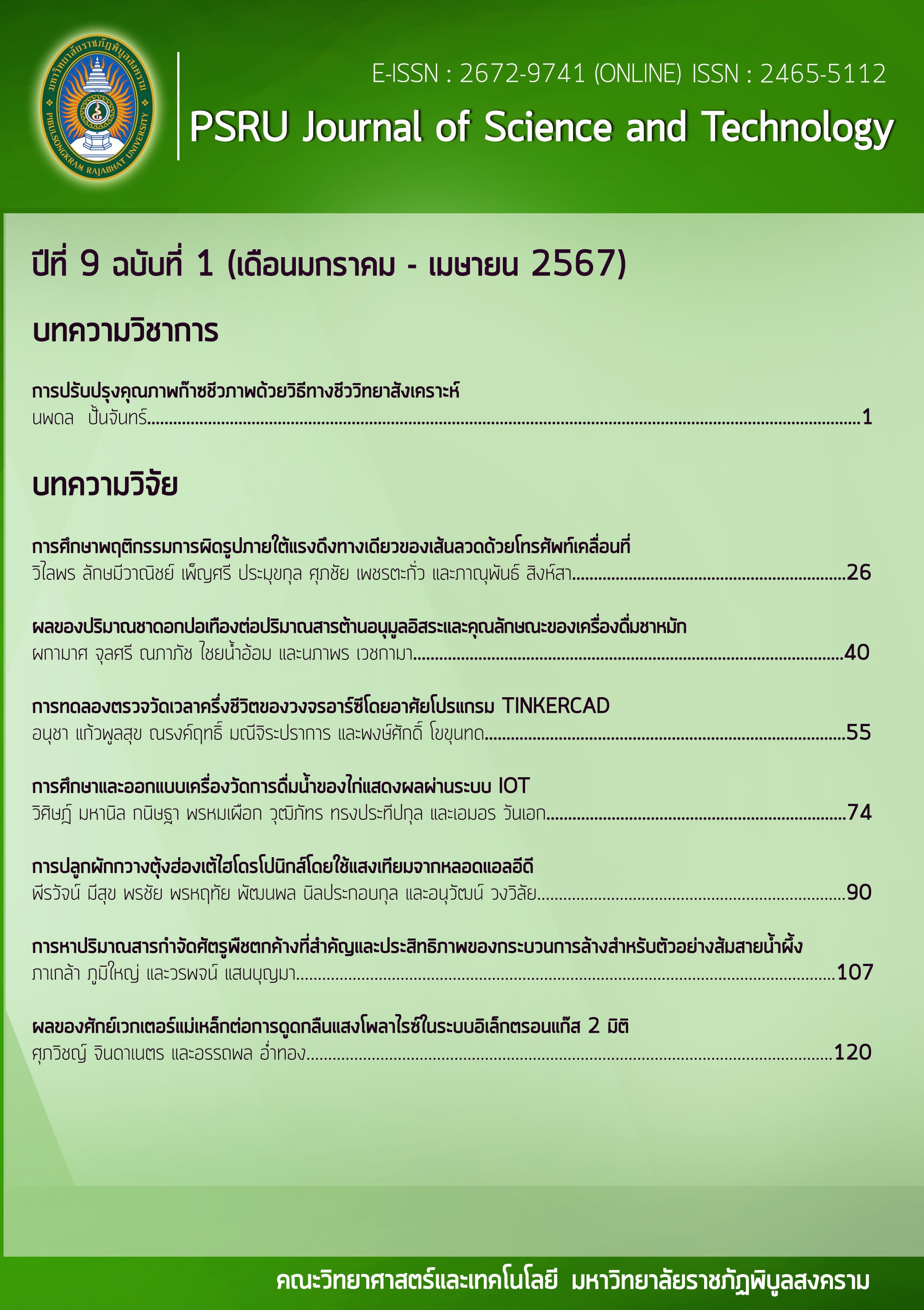A STUDY OF UNIAXIAL DEFORMATION BEHAVIOR OF METAL WIRE USING SMART PHONE
Keywords:
iOS Smart Phone, Tracker Program, Metal Wire, Uniaxial DeformationAbstract
This research is aimed to study the deformation under the uniaxial tensile test of a metal wire with a mobile phone running on the iOS system and recording rate of 60 frames per second. The recorded images were analyzed for positions, changing with time up to theirs breaking points, using the Tracker program 6. The relationship of force and deformed length were then evaluated on the Microsoft Excel Sheets. The results showed that the kits could be employed as an instruction medium for learning about material deformation. The analyzed results, at constant the deformation rate of 50 cm/min, showed an increasing of tensile strength and strain at break depending on the initial wire length of 5–20 cm. The tensile strength increased from 2.5 GPa to 5.1 GPa while the strain a break increased from 1.15 to 2.56.
At a constant wire length of 5 cm, it was found at the elastic range of the wire didn’t depend on deformation rate and it was about 20 percent. These elastic ranges rapidly increased to 35 percent when their initial length increased from 10 to 50 cm, whereas the Young’s modulus of material decreased from 1.4 GPa to 0.8 GPa. The resulting images and their analyzed data are suitable for using as learning media on the elastic properties of the materials for middle and high school levels.
References
นภารัตน์ จิวาลักษณ์, และวิไลพร ลักษมีวาณิชย์. (2565). การทดสอบภายใต้แรงดึงทางเดียวด้วยการติดตามภาพวิดีโอบนโทรศัพท์เคลื่อนที่: กรณีศึกษาการผิดรูปของเส้นด้ายกัญชง. วารสารวิจัยและพัฒนา มจธ., 45(2), 235-245.
พรรัตน์ วัฒนสิกวิชญ์, และจิราภรณ์ ปุณยวัจน์พรกุล. (2555). การวิเคราะห์วิดีโอความเร็วสูงในกลศาสตร์. วารสารวิทยาศาสตร์ มศว., 28(2), 211-232.
สิรินภา กิจเกื้อกูล. (2565). การจัดการเรียนรู้วิทยาศาสตร์ในศตวรรษที่ 21. พิษณุโลก: มหาวิทยาลัยนเรศวร.
Boonrasri, S., Thipchai, P., Sae-Oui, P., Thanakkasaranee, S., Jantanasakulwong, K., & Rachtanapun, P. (2023). Property Improvements of Silica-Filled Styrene Butadiene Rubber/Butadiene Rubber Blend Incorporated with Fatty-Acid-Containing Palm Oil. Polymers. 3429. http://doi.org/10.339./polym15163429
Chean, V., Robin, E., El Abdi, R., & Sangleboeuf, J.C. (2010) Study of the Mechanical Behavior of the Optical Fiber by a Mark-Tracking Method. 14th International Conference on Experimental Mechanics, EPJ Web of Conferences, 6, 34002.
Chean, V., Robin, E., El Abdi, R., Sangleboeuf, J.C., & Houizot, P. (2011). Use of the Mark-tracking Method for Optical Fiber Characterization. Optics and Laser Technology, 43(7), 1172-1178.
Cross, R. (2004). Physics of Overarm Throwing. American Journal of Physics, 72(3), 305-312.
Hu, J., Chen, W., Fan, P., Gao, J., Fang, G. Cao, Z., & Peng, F. (2017). Uniaxial Tensile Tests and Dynamics Mechanical Analysis of Satin Weave Reinforced Epoxy Shape Memory Polymer Composite. Polymer Testing, 64, 235-241.
Instron. (2023). Extensometers. Retrieved 3 November 2023, from https://www.instron.com/en/products/testing-accessories/extensometers
JoVE Science Education Database. (2023). Structural Engineering. Stress-Strain Characteristics of Steels. JoVE, Cambridge, MA. https://www.jove.com/t/10361
Ridwan, R., Prabowo, A.E., Muhayat, N., Putranto, T., & Sohn, J.M. (2020). Tensile Analysis and Assessment of Carbon and Alloy Steels using FE Approach as an Idealization of Material Fractures under Collision and Grounding. Curved and Layered Structures, 7(1), 188-198.
Shan, Y., Cui, H., Zhang, H., & Liu, H. (2022). Deformation Behavior of Rubber Composite Based on FEA and Experimental Verification.Science and Engineering of Composite Materials, 29(1), 194-205.
Sombatsompop, N., Thongsang, S., Markpin, T., & Wimolmala, E. (2004). Fly Ash Particles and Precipitated Silica as Filler in Rubber. I. Untreated Fillers in Natural Rubber and Styrene-Butadiene Rubber Compounds. Journal of Applied Polymer Science, 93(5), 2119-2130.
Stoop, J. (2017). New Ways to Use Smartphones for Science. Retrieved March, 3, 2023, from https://www.elsevier.com/connect/new-ways-to-use-smartphones-for-science
Vahapoglu, V., Karadeniz, S., & Yazici, I. (2011). Uniaxial Tensile Testing of Rubber-Like Materials, Experimental Techniques, 35(1), 17-23.
Yue, S., & Katabi, D. (2021). Liquid Testing with Your Smartphone. Communications of the ACM., 64(10), 75-83.
Zamil, M.S., Yi, H., & Puri, V.M. (2014), Mechanical Characterization of Outer Epidermal Middle Lamella of Onion under Tensile Loading. American Journal of Botany, 101, 778-787.
Zwickroell. (2023). Extensometers. Retrieved 3 November 2023, from https://www.zwickroell.com/company/Extensometers
Downloads
Published
Versions
- 2024-05-29 (2)
- 2024-04-19 (1)
How to Cite
Issue
Section
License
Copyright (c) 2024 PSRU Journal of Science and Technology

This work is licensed under a Creative Commons Attribution-NonCommercial-NoDerivatives 4.0 International License.
กองบรรณาธิการขอสงวนสิทธิ์ในการปรับปรุงแก้ไขตัวอักษรและคำสะกดต่างๆ ที่ไม่ถูกต้อง และต้นฉบับที่ได้รับการตีพิมพ์ในวารสาร PSRU Journal of Science and Technology ถือเป็นกรรมสิทธิ์ของคณะวิทยาศาสตร์และเทคโนโลยี มหาวิทยาลัยราชภัฏพิบูลสงคราม และ
ผลการพิจารณาคัดเลือกบทความตีพิมพ์ในวารสารให้ถือมติของกองบรรณาธิการเป็นที่สิ้นสุด






